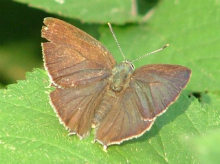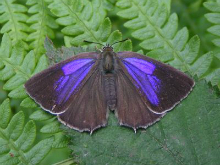
Common around oaks

Distribution and Status
The Purple Hairstreak is fairly widely distributed in the two counties and is common around oaks. It appears to be absent in many parts of west and north-east Hertfordshire as well in the more urban areas in Middlesex. Since numbers hit new peaks in the mid 1990s abundance has declined but 2018 and 2020 were exceptional years with many records of the butterfly seen at low levels. However, it is difficult to gauge long-term trends for this butterfly through its elusiveness and habit of frequenting the tree tops

Habitat Requirements
Mostly in oak woodlands. Small colonies may sometimes be supported on isolated oak trees
Larval Foodplants
Pedunculate Oak Quercus robur, Sessile Oak Q. petraea
Adult Food Sources
Bramble Rubus fruticosus agg., Hemp Agrimony Eupatorium cannabinum, Buddleia Buddleja davidii. Honeydew, ground/mud/road surface
Behaviour/Observation notes
The best time to see the Purple Hairstreak is on a calm warm evening in July on tops of tall oak trees when they are most active, especially the males which defend their territories over the canopy. The butterfly does come down to lower levels on brambles, for example, especially after a spell of rain which may have washed away the honeydew on the oak leaves. Wings are usually closed when feeding but they open occasionally to provide good views of their uppersides
Life History
The Purple Hairstreak is on the wing from the end of June until August with very few lingering on into September. Only one brood is produced each year. Eggs are laid singly on oak twigs or buds and overwinter in this stage. Females are not as selective on aspect or height of the oak trees on where to lay the eggs. Larvae, which emerge in April, feed in the oak buds then the leaves. Pupae are formed in a cocoon usually on the ground

Further information
Photo gallery
Branch Annual Report (2023)
UK distribution map
Full list of larval hostplants (Lycaenidae)
Stevenage butterflies - additional notes
Account for 2022